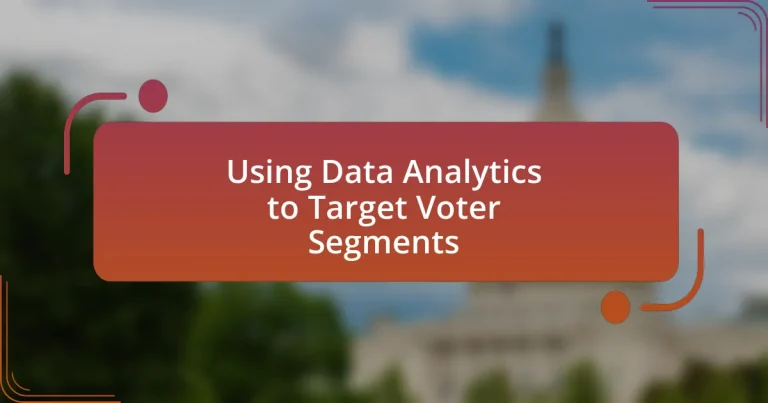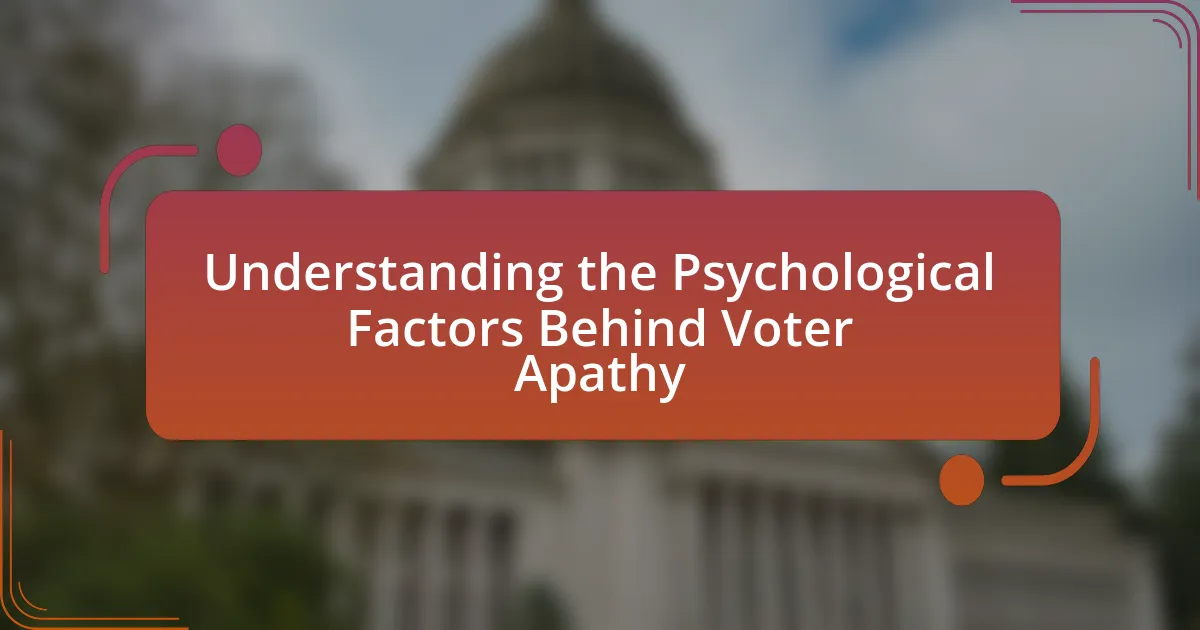Data analytics plays a crucial role in targeting voter segments by systematically examining data related to voter behavior, preferences, and demographics. This article explores how data analytics is applied to understand voter behavior, the types of data collected for analysis, and the techniques used to process and analyze this data. It highlights the importance of targeted messaging in increasing voter turnout and discusses the challenges and ethical considerations associated with data usage in political campaigns. Additionally, the article outlines best practices for ensuring effective and ethical data-driven voter outreach strategies.
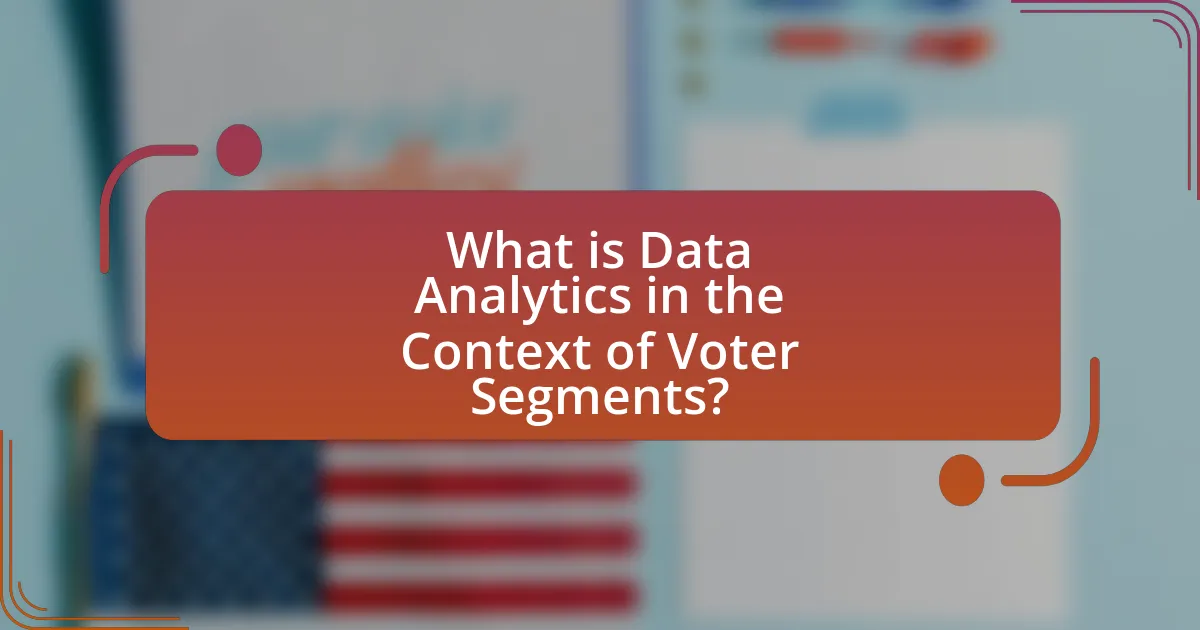
What is Data Analytics in the Context of Voter Segments?
Data analytics in the context of voter segments refers to the systematic examination of data related to voter behavior, preferences, and demographics to identify distinct groups within the electorate. This process involves collecting and analyzing data from various sources, such as surveys, social media, and voting records, to understand the characteristics and motivations of different voter segments. For instance, a study by the Pew Research Center found that demographic factors like age, education, and income significantly influence voting patterns, highlighting the importance of targeted data analytics in political campaigns. By leveraging these insights, political organizations can tailor their messaging and outreach strategies to effectively engage specific voter segments, ultimately enhancing their chances of electoral success.
How does data analytics apply to understanding voter behavior?
Data analytics applies to understanding voter behavior by analyzing large datasets to identify patterns and trends in voting preferences and demographics. This analysis enables political campaigns to segment voters based on various factors such as age, income, education, and past voting behavior, allowing for targeted messaging and outreach strategies. For instance, a study by the Pew Research Center found that data-driven approaches can increase voter turnout by tailoring communication to specific voter segments, thereby enhancing engagement and mobilization efforts.
What types of data are collected for voter analysis?
Voter analysis collects various types of data, including demographic information, voting history, and psychographic profiles. Demographic data encompasses age, gender, race, income, and education level, which helps identify trends and preferences among different voter groups. Voting history includes records of past elections, such as whether individuals voted, their chosen candidates, and participation in primaries, providing insights into voting behavior. Psychographic profiles involve understanding voters’ values, interests, and motivations, often gathered through surveys and social media analysis, which aids in tailoring campaign messages. These data types are essential for effective targeting and engagement strategies in electoral campaigns.
How is this data processed and analyzed?
Data is processed and analyzed through a series of systematic steps that include data collection, cleaning, transformation, and statistical analysis. Initially, data is gathered from various sources such as surveys, social media, and voter registration databases. This raw data is then cleaned to remove inaccuracies and inconsistencies, ensuring that only reliable information is used for analysis.
Following the cleaning process, data is transformed into a suitable format for analysis, which may involve normalization or categorization of data points. Statistical analysis techniques, such as regression analysis or clustering, are then applied to identify patterns and correlations within the data. For instance, clustering can reveal distinct voter segments based on demographics and voting behavior, allowing for targeted outreach strategies.
This methodical approach to data processing and analysis is essential for effectively targeting voter segments, as it enables campaign strategists to make data-driven decisions that enhance voter engagement and increase electoral success.
Why is targeting voter segments important in elections?
Targeting voter segments is important in elections because it allows campaigns to tailor their messages and strategies to specific groups, increasing the likelihood of voter engagement and support. By analyzing demographic data, behavioral patterns, and voting history, campaigns can identify key segments such as young voters, minorities, or undecided voters. For instance, a study by the Pew Research Center found that targeted messaging can significantly influence voter turnout, with campaigns that effectively engage specific demographics seeing up to a 20% increase in participation rates. This strategic approach not only optimizes resource allocation but also enhances the overall effectiveness of electoral efforts.
What impact does targeted messaging have on voter turnout?
Targeted messaging significantly increases voter turnout by effectively engaging specific demographics with tailored content. Research indicates that campaigns utilizing data analytics to segment voters and deliver personalized messages can boost turnout rates by as much as 10% to 20%. For example, a study by the Pew Research Center found that targeted outreach efforts, such as personalized emails and social media ads, led to higher engagement levels among young voters, resulting in increased participation in elections. This demonstrates that when voters receive messages that resonate with their interests and concerns, they are more likely to mobilize and cast their votes.
How can understanding voter segments influence campaign strategies?
Understanding voter segments allows campaign strategies to be tailored to specific demographics, increasing engagement and effectiveness. By analyzing data on voter preferences, behaviors, and demographics, campaigns can identify key segments such as age groups, income levels, and geographic locations. For instance, a study by the Pew Research Center found that targeted messaging can significantly improve voter turnout among specific demographics, as campaigns that address the unique concerns of these groups are more likely to resonate. This targeted approach enables campaigns to allocate resources efficiently, optimize messaging, and ultimately enhance voter mobilization efforts.
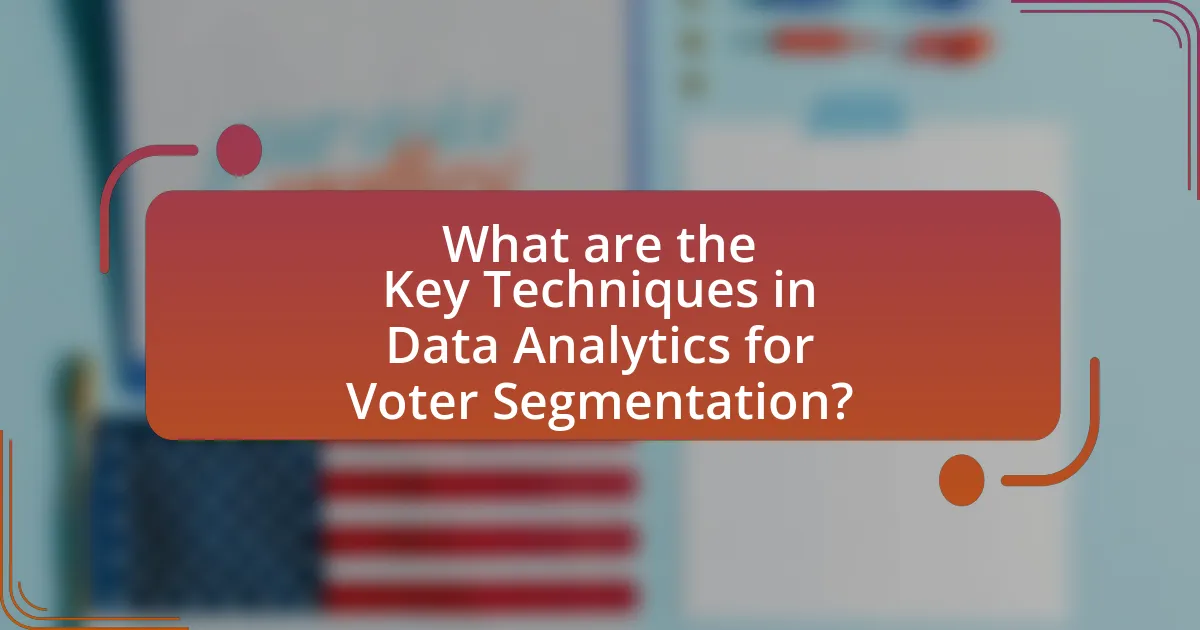
What are the Key Techniques in Data Analytics for Voter Segmentation?
Key techniques in data analytics for voter segmentation include clustering, regression analysis, and predictive modeling. Clustering groups voters based on shared characteristics, such as demographics and voting behavior, allowing for targeted outreach. Regression analysis identifies relationships between variables, helping to understand factors influencing voter decisions. Predictive modeling uses historical data to forecast future voting patterns, enabling campaigns to tailor their strategies effectively. These techniques are supported by data-driven insights, enhancing the precision of voter targeting efforts.
How do predictive analytics contribute to voter segmentation?
Predictive analytics significantly enhances voter segmentation by analyzing historical voting data and demographic information to identify patterns and trends among different voter groups. This analytical approach allows political campaigns to categorize voters based on their preferences, behaviors, and likelihood of voting for specific candidates or issues. For instance, a study by the Pew Research Center found that data-driven strategies can increase voter turnout by tailoring messages to resonate with distinct segments, such as young voters or minority groups. By leveraging predictive models, campaigns can allocate resources more effectively, ensuring that outreach efforts are directed toward the most receptive audiences, ultimately improving engagement and electoral success.
What models are commonly used in predictive analytics for voters?
Commonly used models in predictive analytics for voters include logistic regression, decision trees, and random forests. Logistic regression is frequently employed to estimate the probability of a voter supporting a particular candidate based on various demographic and behavioral factors. Decision trees provide a visual representation of decision-making processes, allowing analysts to identify key attributes influencing voter behavior. Random forests, an ensemble method, enhance prediction accuracy by combining multiple decision trees to reduce overfitting and improve generalization. These models are validated through their application in numerous electoral studies, demonstrating their effectiveness in predicting voter turnout and preferences based on historical voting data and demographic trends.
How accurate are these predictive models in forecasting voter behavior?
Predictive models in forecasting voter behavior have shown varying degrees of accuracy, often ranging from 70% to 90%. For instance, a study by the Pew Research Center found that models utilizing demographic data, past voting behavior, and social media activity can effectively predict voter turnout and preferences. Additionally, the accuracy of these models can be influenced by factors such as the quality of data inputs and the specific algorithms used. In the 2020 U.S. presidential election, many analytics firms reported high predictive accuracy, with some models correctly forecasting state-level outcomes.
What role does demographic data play in targeting voters?
Demographic data plays a crucial role in targeting voters by providing insights into the characteristics, preferences, and behaviors of different voter segments. This data enables political campaigns to tailor their messaging and outreach strategies effectively, ensuring that they resonate with specific groups based on age, gender, ethnicity, income, and education levels. For instance, a study by the Pew Research Center found that demographic factors significantly influence voting patterns, with younger voters tending to favor progressive policies while older voters may prioritize different issues. By analyzing this data, campaigns can allocate resources more efficiently, focus on key demographics that are likely to support their candidates, and ultimately increase voter engagement and turnout.
Which demographic factors are most influential in voter segmentation?
Age, income, education level, and ethnicity are the most influential demographic factors in voter segmentation. Research indicates that age significantly affects voting behavior, with younger voters often leaning towards progressive policies, while older voters tend to favor conservative stances. Income influences voter preferences, as higher-income individuals may prioritize tax policies differently than lower-income voters. Education level correlates with political engagement and party affiliation, with more educated individuals often supporting liberal candidates. Ethnicity plays a crucial role, as different racial and ethnic groups have distinct political priorities and voting patterns, as evidenced by the 2020 U.S. Census data showing varied voting trends among racial demographics.
How can demographic data be effectively utilized in campaigns?
Demographic data can be effectively utilized in campaigns by enabling targeted messaging that resonates with specific voter segments. By analyzing factors such as age, gender, income, education, and geographic location, campaigns can tailor their strategies to address the unique concerns and preferences of different groups. For instance, a study by the Pew Research Center found that younger voters prioritize climate change, while older voters may focus on healthcare issues. This insight allows campaigns to craft messages that align with the values of each demographic, increasing engagement and support. Additionally, utilizing demographic data helps in optimizing resource allocation, ensuring that campaign efforts are concentrated where they are most likely to yield results.
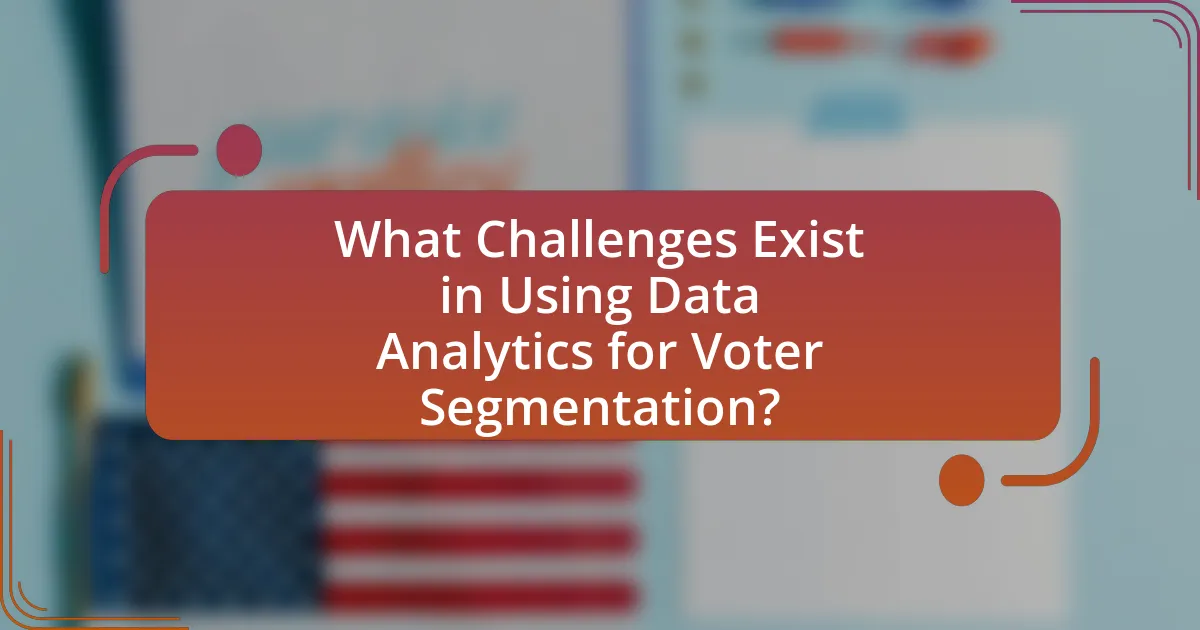
What Challenges Exist in Using Data Analytics for Voter Segmentation?
Challenges in using data analytics for voter segmentation include data privacy concerns, data quality issues, and the complexity of accurately interpreting voter behavior. Data privacy regulations, such as the General Data Protection Regulation (GDPR), restrict how personal data can be collected and used, making it difficult to gather comprehensive voter information. Additionally, data quality can be compromised by incomplete or outdated information, leading to inaccurate segmentation. Furthermore, interpreting voter behavior is complex due to the influence of various socio-economic factors, making it challenging to create effective and targeted campaigns. These challenges highlight the need for careful consideration and robust methodologies in data analytics for voter segmentation.
What ethical considerations must be taken into account?
Ethical considerations in using data analytics to target voter segments include privacy, consent, and potential manipulation. Privacy concerns arise from the collection and use of personal data without individuals’ explicit consent, which can violate data protection laws such as the General Data Protection Regulation (GDPR). Consent is crucial, as individuals should be informed about how their data will be used and have the option to opt-out. Additionally, the potential for manipulation exists when data analytics is used to exploit psychological vulnerabilities, leading to misinformation or undue influence on voter behavior. These considerations are essential to ensure that data analytics practices respect individual rights and promote fair democratic processes.
How can data privacy concerns affect voter data collection?
Data privacy concerns can significantly hinder voter data collection by limiting the types of information that can be gathered and shared. When individuals are apprehensive about how their personal data will be used, they may be less willing to provide accurate or complete information during voter registration or surveys. For instance, the implementation of regulations such as the General Data Protection Regulation (GDPR) in Europe has imposed strict guidelines on data collection practices, compelling organizations to prioritize transparency and consent. This has led to a reduction in the availability of comprehensive voter data, as organizations must navigate complex legal frameworks to ensure compliance, ultimately impacting the effectiveness of data analytics in targeting voter segments.
What regulations govern the use of voter data in campaigns?
The use of voter data in campaigns is primarily governed by the Federal Election Commission (FEC) regulations, which enforce the Federal Election Campaign Act (FECA). These regulations require campaigns to adhere to rules regarding the collection, storage, and use of personal data, ensuring transparency and protecting voter privacy. Additionally, state laws may impose further restrictions on how voter data can be utilized, including consent requirements and data security measures. For instance, the California Consumer Privacy Act (CCPA) provides specific rights to consumers regarding their personal data, which can impact how campaigns operate within that state.
What limitations are associated with data analytics in this context?
Data analytics in the context of targeting voter segments has several limitations, including data privacy concerns, data quality issues, and the potential for misinterpretation of results. Data privacy concerns arise from the ethical implications of collecting and using personal information without consent, which can lead to legal repercussions and loss of public trust. Data quality issues can stem from incomplete or biased datasets, resulting in inaccurate insights that misguide campaign strategies. Additionally, misinterpretation of analytics can occur when data is taken out of context or when correlations are mistaken for causation, leading to ineffective targeting and resource allocation. These limitations highlight the need for careful consideration and ethical practices in data analytics for voter segmentation.
How can data inaccuracies impact voter targeting efforts?
Data inaccuracies can significantly undermine voter targeting efforts by leading to misallocation of resources and ineffective campaign strategies. When voter data contains errors, such as incorrect demographic information or outdated contact details, campaigns may target the wrong segments, resulting in wasted outreach efforts and reduced voter engagement. For instance, a study by the Pew Research Center found that 25% of registered voters had inaccurate information in their voter registration records, which can skew targeting algorithms and diminish the effectiveness of tailored messaging. Consequently, these inaccuracies can hinder a campaign’s ability to mobilize supporters and ultimately impact election outcomes.
What are the risks of over-reliance on data analytics in campaigns?
Over-reliance on data analytics in campaigns can lead to significant risks, including misinterpretation of data, loss of human insight, and ethical concerns. Misinterpretation occurs when data is taken out of context, leading to misguided strategies; for instance, a campaign may focus on a demographic that appears favorable based solely on data, ignoring the nuances of voter sentiment. Loss of human insight happens when campaign teams prioritize data over personal experiences and intuition, potentially alienating voters who seek authentic connections. Ethical concerns arise from privacy issues and the potential for manipulation, as seen in cases where data-driven targeting has been used to exploit voter fears or biases. These risks highlight the necessity of balancing data analytics with human judgment and ethical considerations in campaign strategies.
What Best Practices Should Be Followed When Using Data Analytics for Voter Segmentation?
The best practices for using data analytics in voter segmentation include ensuring data accuracy, employing diverse data sources, and utilizing advanced analytical techniques. Accurate data is crucial as it forms the foundation for reliable insights; for instance, the Pew Research Center highlights that 90% of data-driven decisions rely on data quality. Employing diverse data sources, such as demographic information, voting history, and social media activity, allows for a more comprehensive understanding of voter behavior. Advanced analytical techniques, including machine learning algorithms, can uncover patterns and predict voter preferences effectively, as demonstrated by studies showing that predictive analytics can improve campaign targeting by up to 30%.
How can campaigns ensure ethical data usage while targeting voters?
Campaigns can ensure ethical data usage while targeting voters by adhering to strict data privacy regulations and obtaining informed consent from individuals before collecting their data. This approach aligns with laws such as the General Data Protection Regulation (GDPR), which mandates transparency in data collection and usage. By implementing robust data protection measures and regularly auditing their data practices, campaigns can maintain accountability and build trust with voters. Additionally, utilizing anonymized data analytics can help campaigns target voter segments without compromising individual privacy, thereby promoting ethical standards in their outreach efforts.
What strategies can enhance the effectiveness of data-driven voter outreach?
Utilizing targeted messaging based on data analytics significantly enhances the effectiveness of data-driven voter outreach. By analyzing demographic data, voter behavior, and preferences, campaigns can tailor their communications to resonate with specific voter segments. For instance, a study by the Pew Research Center found that personalized outreach can increase voter engagement by up to 20%. Additionally, leveraging social media analytics allows campaigns to identify and engage with potential voters in real-time, optimizing outreach efforts. Implementing A/B testing on messaging strategies further refines approaches, ensuring that the most effective messages reach the intended audience.
